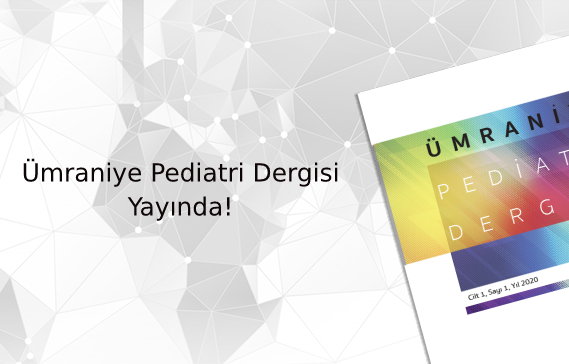2Sağlık ve Bilimler Üniversitesi, Ümraniye Eğitim ve Araştırma Hastanesi, Çocuk Kalp ve Damar Cerrahisi Kliniği, İstanbul, Türkiye
Özet
Amaç: Down sendromu (DS), sık rastlanan kromozomal hastalıklardan biridir ve sıklıkla doğumsal kalp hastalıkları (DKH) ile birliktelik gösterir. Bu çalış-mada, çocuk KVC kliniğimizde yatarak izlenen DS’li hastalardaki DKH’nın tiplerini, komplikasyonlarını ve seyrini değerlendirmeyi amaçladık.
Gereç ve Yöntemler: Eylül 2019–Kasım 2023 tarihleri arasında ÜEAH Çocuk KVC servisinde yatarak tedavi alan tüm hastalar taranarak, DS’ü olduğu tespit edilen 66 hastanın kayıtları retrospektif olarak incelendi.
Bulgular: Hastaların %13,6’sı (n:9) siyanotik kalp hastalığına sahipti. Hastaların kardiyak defektlerine bakıldığında, 31 hastada komplet AVSD, 22 hastada VSD, 4 hastada İntermediate AVSD, 3 hastada Fallot tipi AVSD, 3 hastada Fallot Tetralojisi, 3 hastada tek ventrikül fizyolojisinde unbalance AVSD olduğu görüldü. Hastaların 19’unda (%28,8) 15 günden uzun süreli antibiyotik tedavisi gerektiren sepsis, aritmi, pnömotoraks, şilotoraks gibi komplikasyonlar-dan bir veya birkaçı izlendi. 5 hastada plevral effüzyon vardı, 7 hastada (%10,6) postoperatif aritmi geliştiği görüldü. Mortalite oranı %12,1 idi (n:8). Bu 8 hastanın mortalite nedenlerine bakıldığında, 4’ünde uzun süreli yatış nedeniyle gelişen pnömoni+sepsis olduğu, diğer 4’ünde ise düşük kardiyak debi sendromu (LCOS) ve sepsis olduğu görüldü. Kaybedilen hastaların %88’i kalp yetmezliği kliniği ile gelen AVSD tanılı hastalardı.
Tartışma: Down sendromu olan hastalarda postoperatif aritmi, Down sendromu olmayan hastalara göre daha sık görülmektedir. Bu çalışmada, DS hasta-ların ameliyattan sonra hastanede kalış süresi, diğer çalışmalardaki yatış sürelerine (ortalama 14 gün) nispeten daha kısaydı (ortalama 10,6 gün). DS olan hastalarda postoperatif dönemde daha yüksek enfeksiyon oranının görülmesi, önemli soldan sağa şant nedeniyle pulmoner hipertansiyon (PHT) risklerinin fazla olması, beslenme sorunları, kas hipotonisi, obstrüktif uyku apne sendromu ve tiroid fonksiyon bozukluğu gibi birçok faktör nedeniyle yatış süresi ve mortalite oranları DS olmayan DKH olan hastalara göre daha yüksektir.
2Department of Pediatric Cardiovascular Surgery, University of Health and Scienses, Ümraniye Training and Research Hospital, İstanbul, Türkiye
Abstract
Objective: Down syndrome (DS) is one of the most prevalent chromosomal disorders. It is often comorbid with congenital heart diseases (CHD). In this study, we aimed to assess the types, complications, and course of CHD in patients with DS who have been treated in our Pediatric Cardiovascular Surgery (CVS) clinic.
Material and Methods: Between September 2019 and November 2023, all patients who received inpatient treatment in the ÜEAH Pediatric CVS service were screened, and the records of 66 patients who were found to have DS were retrospectively investigated.
Results: Considering the cardiac defects of the patients, it was seen that 31 patients had complete atrioventricular septal defect (AVSD), 22 patients had ventricular septal defect (VSD), 4 patients had intermediate AVSD, 3 patients had Fallot-type AVSD, 3 patients had tetralogy of Fallot, and 3 patients had unbalanced AVSD in single ventricular physiology. One or more of the complications such as sepsis, arrhythmia, pneumothorax, and pleural effusion were observed in 19 (28.8%) of the patients. Pleural effusion was observed in 5 patients. Post-operative arrhythmia was observed in 7 patients (10.6%). The mortality rate of the patients was 12.1%. When examining the causes of mortality of these 8 patients, it was seen that 4 of them had pneumonia + sepsis due to long-term hospitalization, whereas the other 4 had low cardiac output syndrome (LCOS) and sepsis. 88% of the deceased patients were admitted to the clinic with heart failure and diagnosed with AVSD.
Conclusion: In this study, the post-surgical hospital stay of DS patients was relatively shorter (mean 10.6 days) than the length of stay (mean 14 days) in other studies. Due to several factors such as higher rates of infection in patients with DS during the post-surgical stage, higher risks of pulmonary hypertension (PHT) emerging from the significant left-to-right shunt, nutritional problems, muscle hypotonia, obstructive sleep apnea syndrome, and thyroid malfunction, the rates of hospital stay and mortality rates in DS patients with CHD are relatively higher.






 Recep Çetin1
Recep Çetin1 





